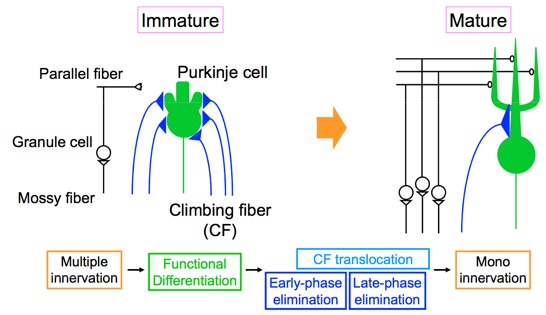Our Research
From synapse to brain development, learning and memory
The brain consists of neural circuits in which neurons are connected through numerous synapses. Therefore, study of synapses is a key to the understanding of development, learning and memory. We are investigating modulation of synaptic transmission (I), postnatal development of synaptic function and connection (II), and operation of synapses and neurons in the brain (III).
(I) Retrograde modulation of synaptic transmission by endogenous cannabinoids
We discovered in 2001 that endogenous cannabinoids (endocannabinoids) are released from postsynaptic neurons and “retrogradely” suppress transmitter release from presynaptic terminals. We have elucidated the basic mechanisms of endocannabinoid release from activated neurons. Endocannabinoids are now regarded as a major synaptic modulator like dopamine and serotonin, and also known to be involved in higher brain functions including learning and memory.


- Ohno-Shosaku, T., Maejima, T. & Kano, M.: Endogenous cannabinoids mediate retrograde signals from depolarized postsynaptic neurons to presynaptic terminals. Neuron 29: 729-738, (2001).
- Maejima, T., Hashimoto, K., Yoshida, T., Aiba, A. & Kano, M.: Presynaptic inhibition caused by retrograde signal from metabotropic glutamate to cannabinoid receptors. Neuron 31: 463-475, (2001).
- Hashimotodani, Y., Ohno-Shosaku, T., Tsubokawa, H., Ogata, H., Emoto, K., Maejima, T., Araishi, K., Shin, H-S. & Kano, M.: Phospholipase Cbeta serves as a coincidence detector through its Ca2+ dependency for triggering endocannabinoid signal. Neuron 45: 257-268, (2005).
- Kano M, Ohno-Shosaku T, Hashimotodani Y, Uchigashima M, Watanabe M: Endocannabinoid-mediated control of synaptic transmission. Physiol. Rev. 89: 309-380 (2009).
- Tanimura A, Yamazaki, M, Hashimotodani Y, Uchigashima, M, Kawata S, Abe M, Kita Y, Hashimoto K, Shimizu T, Watanabe M, Sakimura K, Kano, M: The endocannabinoid 2-arachidonoylglycerol produced by diacylglycerol lipase α mediates retrograde suppression of synaptic transmission. Neuron 65: 320-327, (2010).
- Tanimura A, Uchigashima M, Yamazaki M, Uesaka N, Mikuni T, Abe M, Hashimoto K, Watanabe M, Sakimura K & Kano M.: Synapse type-independent degradation of the endocannabinoid 2-arachidonoylglycerol after retrograde synaptic suppression. Proc Natl Acad Sci U S A. 109: 12195-121200 (2012).
(II) Postnatal development and synapse elimination in the cerebellum
In early postnatal days, all Purkinje cells in the cerebellum are innervated by multiple climbing fibers. These surplus climbing fibers are eliminated eventually and most Purkinje cells become innervated by single climbing fibers (synapse elimination). We have disclosed that this process involves four distinct events. Knowledge obtained in this simple model system provides important insight into how functional neural circuits are formed in the developing brain.

- Kano, M., Hashimoto, K., Chen, C., Abeliovich, A., Aiba, A., Kurihara, H., Watanabe, M., Inoue, Y. & Tonegawa, S.: Impaired synapse elimination during cerebellar development in PKC gamma mutant mice. Cell 83: 1223-1231, (1995).
- Ichise, T., Kano, M., Hashimoto, K., Yanagihara, D., Nakao, K., Shigemoto, R., Katsuki, M. & Aiba, A.: mGluR1 in cerebellar Purkinje cells essential for long-term depression, climbing fiber synapse elimination and motor coordination. Science 288: 1832-1835, (2000).
- Hashimoto, K. & Kano, M.: Functional differentiation of multiple climbing fiber inputs during synapse elimination in the developing cerebellum. Neuron 38: 785-796, (2003).
- Hashimoto, K., Ichikawa, R., Kitamura, K., Watanabe, M. & Kano, M.: Translocation of a "winner" climbing fiber to the Purkinje cell dendrite and subsequent elimination of "losers" from the soma in developing cerebellum. Neuron 63: 106-118, (2009).
- Hashimoto K, Tsujita M, Miyazaki T, Kitamura K, Yamazaki M, Shin H-S, Watanabe M, Sakimura K, Kano M: Postsynaptic P/Q-type Ca2+ channel in Purkinje cell mediates synaptic competition and elimination in developing cerebellum. Proc Natl Acad Sci USA 108: 9987-9992, (2011).
- Uesaka N, Mikuni T, Hashimoto K, Hirai H, Sakimura K, & Kano M: Organotypic Coculture Preparation for the Study of Developmental Synapse Elimination in Mammalian Brain. J. Neurosci. 32: 11657-11670 (2012).
- Nakayama H, Miyazaki T, Kitamura K, Hashimoto K, Yanagawa Y, Obata K, Sakimura K, Watanabe M & Kano M: GABAergic inhibition regulates developmental synapse elimination in the cerebellum. Neuron 74: 384-396 (2012).
- Uesaka N, Uchigashima M, Mikuni T, Nakazawa T, Nakao H, Hirai H, Aiba A, Watanabe M & Kano M.: Retrograde Semaphorin Signaling Regulates Synapse Elimination in the Developing Mouse Brain. Science 344: 1020-1023 (2014).
III) Two-photon imaging of neural activities in intact brain
We are investigating neuronal activities, calcium signaling and synaptic responses in the cerebellum and cerebral cortex of intact animals by using two-photon microscopy. This approach enables us to elucidate how neurons and synapses operate to process neural information in living animals.


- Kitamura, K., Judkewitz, B., Kano, M., Denk, W. & Hausser, M.: Targeted patch-clamp recordings and single-cell electroporation of unlabeled neurons in vivo. Nat. Methods 5: 61-67 (2008).
- Schultz, S. R., Kitamura, K., Post-Uiterweer, A., Krupic, J. & Häusser, M.: Spatial pattern coding of sensory information by climbing-fiber evoked calcium signals in networks of neighboring cerebellar Purkinje cell. J. Neurosci., 29, 8005-8015 (2009).
- Judkewitz, B., Rizzi, M., Kitamura, K. & Häusser, M.: Targeted in vivo single-cell electroporation. Nat. Protoc. 4: 862 - 869 (2009).
- Kitamura K & Häusser M: Dendritic Calcium Signaling Triggered by Spontaneous and Sensory-Evoked Climbing Fiber Input to Cerebellar Purkinje Cells In Vivo. J. Neurosci. 31: 10847-10858 (2011).
- Takahashi N, Kitamura K, Matsuo N, Mayford M, Kano M, Matsuki N & Ikegaya Y: Locally synchronized synaptic inputs. Science 335: 353-356 (2012).
We encourage young motivated students to join us and to extend research “from synapse to brain development, learning and memory.”




